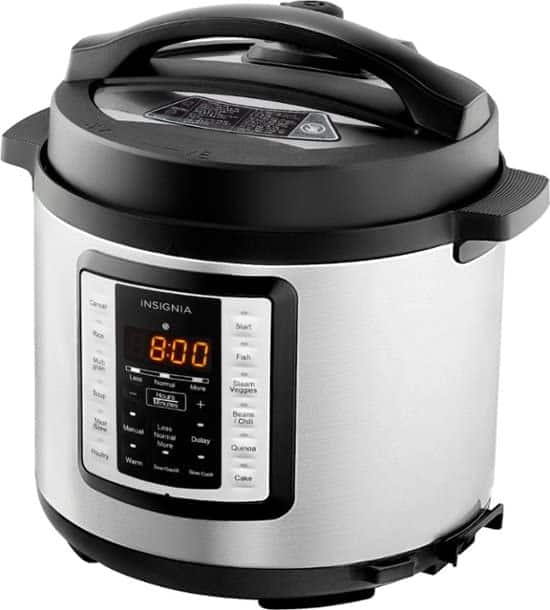
Insignia pressure cookers offer convenient multi-function cooking, but sometimes issues arise. Understanding common problems and their solutions can help you quickly troubleshoot your Insignia pressure cooker and get back to preparing delicious meals.
From error codes to sealing problems, various issues may occur when using your cooker. We’ll explore typical difficulties and provide step-by-step fixes. You’ll learn how to address problems like the C5 error code, which often relates to the lid not being properly closed.
Proper maintenance is key to preventing issues. We’ll cover essential care tips, including cleaning the silicon cap and floating valve. By following these guidelines, you can keep your Insignia pressure cooker working smoothly for years to come.
| Common Issue | Quick Fix |
|---|---|
| C5 Error | Check lid closure |
| Not sealing | Inspect sealing ring |
| No pressure | Verify valve position |
Getting Started with Your Insignia Pressure Cooker
Familiarize yourself with your Insignia pressure cooker’s parts and set it up properly. This will ensure safe and effective use of your new kitchen appliance.
Quick Solutions to Common Insignia Pressure Cooker Problems
Insignia pressure cookers are reliable kitchen appliances, but like any device, they can run into issues from time to time. Whether you’re seeing error codes, struggling with lid alignment, or wondering why your rice always sticks to the bottom, these solutions cover the most frequent problems owners face—and how to fix them quickly without calling support or returning your cooker.
Error Code C5 – Overheating or Dry Pot
This is one of the most common issues users encounter. Error C5 means the cooker is overheating, usually because there’s not enough water inside the pot, or the pot was left completely dry.
Solution:
- Add at least one cup of water or broth before pressure cooking to maintain safe internal temperatures.
- Ensure the inner pot is fully inserted and properly seated in the cooker.
- Always deglaze the bottom of the pot after sautéing to prevent burnt residue from triggering a heat warning.
Can’t Change the Cooking Time
Insignia models often require you to use preset programs before adjusting the cooking time. If you’re trying to set a custom time but nothing happens, you’re probably skipping a step.
Solution:
- First, select a preset cooking function (e.g., Rice, Meat, Steam).
- Then use the Time Increase or Decrease buttons to adjust duration before the countdown starts.
- If the display is circling without a countdown, the unit is likely still building pressure, especially with larger liquid volumes.
Food Sticking to the Pot
Sticky rice or burnt food can ruin a meal—and make cleanup a hassle. This usually comes down to a combination of recipe issues and pot maintenance.
Solution:
- Make sure you’re adding enough liquid for the recipe type—especially for grains, legumes, or starchy foods.
- Clean the inner pot thoroughly after each use. Any leftover residue can cause sticking next time around.
- Consider using a non-stick or ceramic-coated inner pot if you frequently cook delicate foods.
Lid Won’t Close or Open
Difficulty locking or unlocking the lid can be frustrating, especially when steam is involved. This is often due to pressure still being present inside or a misaligned gasket.
Solution:
- Never force the lid. If it won’t open, wait until all internal pressure is released through the float or quick-release valve.
- Ensure the silicone gasket is properly seated and not warped or twisted.
- Align the triangle markers on both the lid and the body when opening or closing. Misalignment is a common oversight.
- If the red float valve is stuck, gently push it with a utensil or your finger once the unit is fully depressurized.
Steam or Water Leaking During Cooking
Excessive steam escaping from the sides or top usually means a poor seal or blocked valve. Pressure cooking relies on a tight seal, so leaks prevent the unit from reaching and maintaining pressure.
Solution:
- Double-check the gasket for wear, debris, or improper placement. Replace it every 12-18 months for best performance.
- Ensure the lid is locked tightly and the pressure valve is in the “Sealing” position before starting a cycle.
- Clean the float valve and pressure release valve thoroughly. Even tiny food particles can cause a leak.
- If the valve or gasket seems faulty, replacement parts are affordable and widely available online.
Buttons Not Responding
Sometimes the display or controls stop responding altogether, which can indicate a firmware glitch or power issue.
Solution:
- Unplug the unit, wait for 5 minutes, then plug it back in to perform a soft reset.
- Check the outlet and breaker to ensure your cooker is getting power.
- If the buttons are still unresponsive, inspect the control panel for physical damage or signs of moisture intrusion.
Cooker Won’t Pressurize
This silent failure is one of the trickiest to diagnose. The cooking cycle might start, but the pressure never builds, and food remains undercooked.
Solution:
- Make sure there’s enough liquid—at least 1 cup of water or broth is needed for most recipes.
- Check for steam escaping from the lid. If you see or hear leaking, the gasket may not be seated properly or the float valve might be stuck.
- Clean the pressure valve to remove any debris that could block proper pressure build-up.
- Verify the lid is fully locked and the pressure release knob is set to “Seal.”
How to Reset an Insignia Pressure Cooker
If all else fails or you’ve encountered multiple issues, a full reset can sometimes solve unexplained problems.
Steps:
- Turn off and unplug the unit.
- Wait for 5–10 minutes to ensure any residual power is discharged.
- Plug the cooker back in and try a simple cooking function like “Steam” to test responsiveness.
If your cooker continues acting up after a reset, you may be dealing with a deeper hardware fault. Most Insignia cookers come with a 1-year limited warranty, so check your receipt and consider a return or replacement if necessary.
Maintaining Your Insignia Pressure Cooker for Long-Term Use
Prevention is always better than troubleshooting. Here’s how to keep your cooker in top shape:
- Clean the lid, inner pot, gasket, and valves after each use.
- Replace the gasket and float valve yearly or sooner if you notice deformation.
- Store the lid upside down to allow air flow and prevent odors.
- Run a steam-cleaning cycle monthly with water and vinegar to remove internal buildup.
Insignia pressure cookers are budget-friendly and powerful, but like any kitchen tool, they need a bit of care and understanding. With these quick solutions, you’ll be back to cooking stress-free in no time.
Understanding Your Cooker’s Components
The Insignia NS-MC80SS9 and NS-MC60SS9 models have similar key components. These include:
- Lid with sealing ring
- Pressure release valve
- Float valve
- Inner pot
- Heating element
- Control panel
The lid locks in place during cooking. Check the sealing ring before each use to prevent steam leaks. The pressure release valve controls steam exit. The float valve indicates pressure inside the cooker.
The removable inner pot is where you place food. The heating element sits beneath it. Use the control panel to select cooking functions and times.
Initial Setup and Specifications
Before first use, wash the inner pot and accessories with warm soapy water. Dry them thoroughly. Place the cooker on a flat, stable surface away from heat sources.
Specifications for common Insignia models:
| Model | Capacity | Wattage | Pressure Levels |
|---|---|---|---|
| NS-MC60SS9 | 6 quart | 1000W | 2 |
| NS-MC80SS9 | 8 quart | 1200W | 2 |
Plug the cooker into a grounded outlet. Never use an extension cord. Check that the power cord is securely connected and the outlet works.
To test your cooker, add 3 cups of water to the inner pot. Close and lock the lid. Select the “Steam” function and set for 2 minutes. After the cycle, use the quick release method to vent steam.
Operating Your Pressure Cooker
Using your Insignia pressure cooker effectively involves understanding its key features and functions. Proper operation ensures safety and optimal cooking results.
Control Panel Features and Settings
The control panel on Insignia pressure cookers offers various functions for easy meal preparation. It typically includes buttons for different cooking programs, timer settings, and pressure levels.
Pressure release valve controls are essential for safe operation. Familiarize yourself with the pressure indicator and floating valve positions.
Most models feature a digital display showing cooking time and status. Common preset buttons include Rice, Soup, Meat, and Manual modes.
Always refer to your specific model’s manual for exact button layouts and functions.
Filling with Food and Using Cooking Programs
When filling your Insignia pressure cooker, never exceed the maximum fill line marked inside the inner pot. For foods that expand during cooking, fill only to the halfway mark.
Add at least 1 cup of liquid for proper pressure build-up. Place the inner pot into the cooker base, ensuring the exterior is clean and dry.
To use a cooking program:
- Select the desired preset on the control panel
- Adjust time if needed
- Close and lock the lid
- Ensure the pressure release valve is set to “Sealing”
The cooker will start automatically after a few seconds.
Cook Time, Timer, and Delay Timer Usage
Adjust cooking times using the + and – buttons on the control panel. The digital display shows the selected duration.
For manual cooking:
- Press the “Manual” button
- Set desired cook time
- Choose pressure level (if applicable)
Use the delay timer to schedule cooking up to 24 hours in advance:
- Select cooking program
- Press “Delay Timer”
- Set the number of hours to delay
- The cooker will start automatically when time is up
Remember, don’t use the delay timer for perishable foods.
Opening the Lid and Post-Cooking Processes
After cooking, allow natural pressure release for 10-15 minutes. For quick release, carefully turn the pressure valve to “Venting.”
Wait for the floating valve to drop before opening the lid. Always open the lid away from your face to avoid steam burns.
Use oven mitts when removing the inner pot. The “Keep Warm” function activates automatically after cooking to maintain food temperature.
To cancel a cooking program or turn off the cooker, press the “Cancel” button.
Clean the lid, gasket, and inner pot after each use. Inspect the gasket regularly for wear and tear to ensure proper sealing.
Troubleshooting Common Issues
Pressure cooker problems can often be resolved with simple fixes. Knowing how to address steam leaks, valve issues, lid malfunctions, and error messages will help keep your Insignia pressure cooker running smoothly.
Identifying and Fixing Steam Leaks
Steam leaks can prevent proper pressurization. Check the rubber gasket for damage or misalignment. Clean it thoroughly and ensure it’s properly seated in the lid groove.
Inspect the pressure release valve for food debris. Clean it gently with warm soapy water. Make sure it’s correctly positioned before cooking.
Examine the lid for warping or damage. A damaged lid may need replacement to maintain a proper seal.
If steam escapes from the rim, try these steps:
- Tighten the lid
- Reposition the gasket
- Replace the gasket if worn
Pressure Release Valve and Gasket Concerns
A faulty pressure release valve can cause safety issues. If it’s not sealing properly:
- Clean the valve thoroughly
- Check for obstructions
- Ensure it moves freely
Replace the valve if cleaning doesn’t resolve the problem.
For gasket issues:
- Look for cracks or stretching
- Clean with warm soapy water
- Dry completely before reinserting
Replace the gasket annually or if it shows signs of wear.
Troubles with the Lid Lock and Seal
A properly functioning lid lock is crucial for safety. If the lid won’t lock:
- Check for food debris in the locking mechanism
- Ensure the gasket is correctly positioned
- Verify the float valve moves freely
For sealing problems:
- Inspect the sealing ring for damage
- Clean the lid and pot rim
- Apply a thin layer of cooking oil to the gasket
If issues persist, consult your manual for model-specific troubleshooting steps.
Addressing Error Messages and Alert Sounds
Error codes and beeps can indicate various issues. Here’s a quick guide:
| Error Code | Possible Cause | Solution |
|---|---|---|
| E1 | Faulty sensor | Contact support |
| E2 | Overheating | Add liquid, clean bottom of pot |
| E3 | Lid not sealed | Reposition lid, check gasket |
For continuous beeping:
- Release pressure immediately
- Check for sufficient liquid
- Ensure the pressure valve is set correctly
If you hear hissing, verify the pressure release valve is in the sealing position. For persistent errors or unusual sounds, consult your user manual or contact Insignia customer support.
Maintaining Your Insignia Pressure Cooker
Regular maintenance keeps your Insignia pressure cooker functioning safely and efficiently. Proper cleaning and timely replacements ensure optimal performance and longevity.
Cleaning Guidelines
Clean your Insignia pressure cooker after each use. Unplug the unit and let it cool completely before cleaning. Remove the inner pot and wash it with warm, soapy water. Use a soft sponge to avoid scratching the surface.
Wipe the exterior with a damp cloth. Don’t submerge the base in water. Clean the lid thoroughly, paying special attention to the floating valve and pressure release valve.
Remove and clean the silicone sealing ring. Wash it in warm, soapy water and dry completely before reinserting. Check for any cracks or damage.
Empty and rinse the condensation collector after each use. Wash it with mild soap and water.
| Part | Cleaning Method |
|---|---|
| Inner Pot | Warm, soapy water |
| Exterior | Damp cloth |
| Lid | Thorough cleaning, focus on valves |
| Sealing Ring | Warm, soapy water, check for damage |
| Condensation Collector | Rinse and wash with mild soap |
Replacements and Warranty Information
Your Insignia pressure cooker comes with a one-year limited warranty. This covers defects in materials and workmanship under normal use. Keep your receipt as proof of purchase.
Replace the sealing ring every 12-18 months or sooner if you notice any wear. Use only Insignia-approved replacement parts to maintain safety and performance.
Check the floating valve and pressure release valve regularly for damage or blockage. Replace if necessary to ensure proper pressure regulation.
If you need replacements outside the warranty period, contact Insignia customer service or visit their website. They offer genuine parts and accessories for your specific model.
Frequently Asked Questions
Pressure cooker issues can be frustrating. Let’s address common problems and their solutions to keep your Insignia cooker working smoothly.
Why is my pressure cooker not turning on?
Check if the power cord is plugged in securely. Ensure the outlet works by testing it with another device. If these steps fail, inspect the power cord for damage. Replace the cord if needed.
What are the steps to reset a pressure cooker?
Unplug the cooker and wait 10 minutes. Plug it back in and press the “Stop” button. This often resolves minor glitches. If issues persist, consult your manual for model-specific reset instructions.
How can I replace the float valve on my pressure cooker?
Locate the float valve on the lid’s underside. Remove the silicone cap and gently pull out the old valve. Insert the new valve and replace the cap. Test it by moving it up and down to ensure proper installation.
Why is the pressure cooker not building up pressure appropriately?
Check the sealing ring for damage or misalignment. Ensure the steam release valve is in the sealed position. Clean any food debris from the rim of the pot and lid. Add enough liquid to create steam.
What should I do if my pressure cooker doesn’t pressurize?
Verify that you’ve added enough liquid. Check for a proper seal on the lid. Inspect the sealing ring and steam release valve. Clean any obstructions from the float valve. If problems continue, the heating element may need repair.
How do I interpret the error symbols displayed on my pressure cooker?
Error codes vary by model. Common codes include:
| Error Code | Meaning | Solution |
|---|---|---|
| C5 | Overheating | Remove food buildup from pot bottom |
| E1 | Sensor failure | Contact customer support |
| OH | Overheat | Allow cooker to cool, check for food residue |
Consult your user manual for specific error code meanings and recommended actions.





